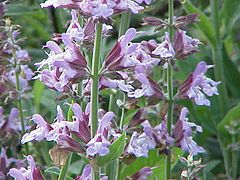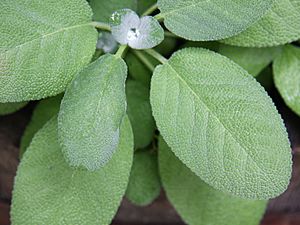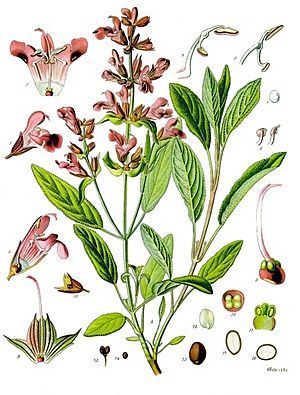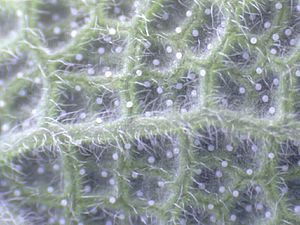Common sage facts for kids
Quick facts for kids Common sage |
|
|---|---|
 |
|
| flowers | |
| Scientific classification | |
| Kingdom: | |
| Division: | |
| Class: | |
| Order: | |
| Family: | |
| Genus: | |
| Species: |
S. officinalis
|
| Binomial name | |
| Salvia officinalis |
|
Common sage (scientific name: Salvia officinalis) is a popular plant. It is also known as garden sage or culinary sage. This plant is a small, woody bush that stays green all year. It has grayish leaves and pretty blue or purple flowers.
Sage belongs to the mint family, called Lamiaceae. It originally comes from the Mediterranean region. But now, you can find it growing naturally in many parts of the world. People have used sage for a very long time in cooking and as a medicine. Today, it is also a popular plant for gardens.
Contents
What is Sage Called?
Salvia officinalis has many common names. Some of the most well-known names are sage, common sage, and garden sage. People also call it golden sage, kitchen sage, or true sage. The word officinalis in its scientific name means that the plant has been used for medicine or cooking for a long time.
Sage's Family Tree
The famous scientist Carl Linnaeus first described Salvia officinalis in 1753. For hundreds of years, people in the Old World (Europe, Asia, Africa) grew sage. They used it for food and for its healing powers. Old books about plants, called herbals, often wrote about the amazing things sage was thought to do.
What Sage Looks Like

Sage plants can look different depending on their type. They vary in size, leaf color, and flower color. Some even have leaves with different patterns. The traditional type of sage grows to about 2 feet (0.6 meters) tall and wide. Its flowers are usually lavender, but they can also be white, pink, or purple. Sage flowers in late spring or summer.
The leaves are shaped like long ovals. They can be up to 2.5 inches (6.4 cm) long and 1 inch (2.5 cm) wide. Sage leaves are grey-green and have a bumpy surface on top. The underside of the leaves looks almost white because of many short, soft hairs. Today, you can find types of sage with leaves that are purple, rose, cream, or yellow. Many have cool mixed color patterns.
Sage Through History
People have used Salvia officinalis since ancient times. They believed it could help with many things. For example, it was thought to ward off evil or help with snakebites. The ancient Greek writer Theophrastus wrote about two kinds of sage. The Roman writer Pliny the Elder said the Romans called it salvia. They used it to help the body get rid of extra water and to stop bleeding.
In the early Middle Ages, Charlemagne suggested growing sage in gardens. Monasteries often grew it. A poet named Walafrid Strabo wrote about sage in his poem Hortulus. He said it smelled sweet and was good for many human sicknesses.
Sage was very popular in the Middle Ages. Many sayings talked about its healing powers. People sometimes called it S. salvatrix, which means "sage the savior." It was even an ingredient in "Four Thieves Vinegar." This was a mix of herbs believed to protect against the plague.
Old doctors like Dioscorides, Pliny, and Galen all suggested sage for different health issues. John Gerard's Herball (1597) said sage was "singularly good for the head and brain." He wrote that it "quickens the senses and memory." In the past, sage was also used for hair care and insect bites. It was thought to help with nervous conditions and reduce fevers.
How Sage is Used
Cooking with Sage
In Britain, sage is one of the most important herbs. It is often used with parsley, rosemary, and thyme. Sage has a savory, slightly peppery taste. You can find it in many European, Balkan, and Middle Eastern dishes.
In Italian cuisine, sage is key for dishes like saltimbocca. It is also often used with fish. In British and American cooking, sage is a traditional part of "sage and onion stuffing." This stuffing is often served with roast turkey or chicken for Christmas or Thanksgiving Day. Other foods that use sage include pork casseroles and certain cheeses like Sage Derby. Even though many herbs are used in French cuisine, sage is not as popular there.
Sage Essential Oil
Common sage is grown in parts of Europe to make an essential oil. This oil contains natural chemicals like cineole and thujone. Sage leaves also have other helpful compounds.
Health Benefits of Sage
Studies have shown that sage extracts can help improve memory and attention in healthy people. It can also make people feel more alert and improve their mood. One study with people who had Alzheimer's disease showed that sage extract helped improve their thinking and behavior. Sage extracts might even boost brain power, similar to the caffeine in tea and coffee.
Types of Sage Plants
In a garden, S. officinalis can grow quite large. But there are many different types, called cultivars, that are smaller. These types are often grown as pretty flowering shrubs, not just for their herbal uses. Some types of sage can even cover the ground, especially in sunny, dry places.
Sage plants can be harmed by cold, wet winters, especially if the soil does not drain well. But it is easy to grow new plants from cuttings in the summer. Some types can also be grown from seeds.
Here are some popular types of sage:
- 'Alba': This type has white flowers.
- 'Aurea': This is known as golden sage.
- 'Berggarten': This type has large leaves and rarely blooms. This means its leaves stay useful for longer.
- 'Extrakta': The leaves of this type have more oil.
- 'Icterina': This type has yellow-green leaves with mixed colors.
- 'Lavandulaefolia': This type has small leaves.
- 'Purpurascens' ('Purpurea'): This type has purple leaves.
- 'Tricolor': This type has leaves with white, purple, and green mixed colors.
'Icterina' and 'Purpurascens' have won an award from the Royal Horticultural Society for being great garden plants.
Related pages
Images for kids
See also
 In Spanish: Salvia officinalis para niños
In Spanish: Salvia officinalis para niños











